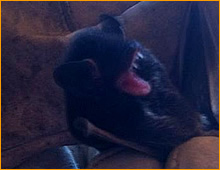Lesser Long-Nosed Bat Control & Removal
 Lesser Long Nosed Bat Control and Removal is a professional service that should be handled by a professional bat removal and control professional, You can find a professional bat removal company here.
Lesser Long Nosed Bat Control and Removal is a professional service that should be handled by a professional bat removal and control professional, You can find a professional bat removal company here.
The lesser long-nosed bat is one of three North American bat species that feed exclusively on the fruit and nectar of night-blooming cacti including saguaro and organ pipe, as well as many species of agave. In the US, lesser long-nosed bats are found in southern Arizona and southwestern New Mexico. They are crucial players in desert ecology: in addition to pollinating the cactus' flowers, which enables them to reproduce, they also disperse the seeds of the fruits so new plants can grow. In the absence of long-nosed bats, the seed set of the agave plummets to one-three-thousandth of normal.
Adult lesser long-nosed bats are yellow-brown to gray above, with rusty brown fur on their belly. If you’re lucky enough to have them hold still for long enough, you’ll be able to see their trademark triangular noseleaf that juts from the end of their noses. Juveniles are gray in color.
Lesser long-nosed bats roost mainly in caves and abandoned mines, but have been found occasionally in abandoned buildings. Roost disturbance and over-harvesting of agaves represent the primary threats for these bats (they’re classified as endangered).
If you find one or two of these bats in your home, chances are they have wandered in by mistake. They’ll often enter homes through open windows and doors, but may use any crevice they can find. This usually occurs in spring when bats are checking for potential roost sites. The presence of any bat in your living spaces is purely accidental; it is often a simple matter to allow it to escape.
Any bat will usually find its own way out; jut open all windows and doors leading to the outside. Bats usually will not attack a person even if chased. Never swat or throw things at the bat, or run around waving. All this tends to do is confuse the bat and leave you exhausted. Above all else, calmly watch the bat to make sure it leaves. If the bat refuses to leave, it will calm down and land on something. Drapes and hanging clothes seem to be the preferred rest areas. Place a small box or can over the bat, then gently slide thin cardboard under the "trap" to collect your bat, then release it outside. At last resort, local health authorities can be called to collect the bat, though this may result in its demise. If a bat, or any wild animal, has come in contact with pets, children, or other vulnerable person, contact your local health department. Health department recommendations vary from state to state.
Professional Measures to control Lesser Long Nosed Bats
There’s a couple of ways a professional bat exclusion professional can help. They can tell you which kind of bats occur in your area, and possibly help you determine which bat you’re dealing with. They can also inspect your house for possible entrance points (these can be quite small), and advise you on exclusion measures to take. If you want to go this road, look for a company who:
· has experience finding all the tiny entrances bats use to enter and exit a structure, and in sealing up those gaps.
· uses only the most effective exclusion and removal techniques, in compliance with all state and local regulations.
We have many pages on several different species of bats, please use our main bat removal page for specific species of bats needing controlled.
